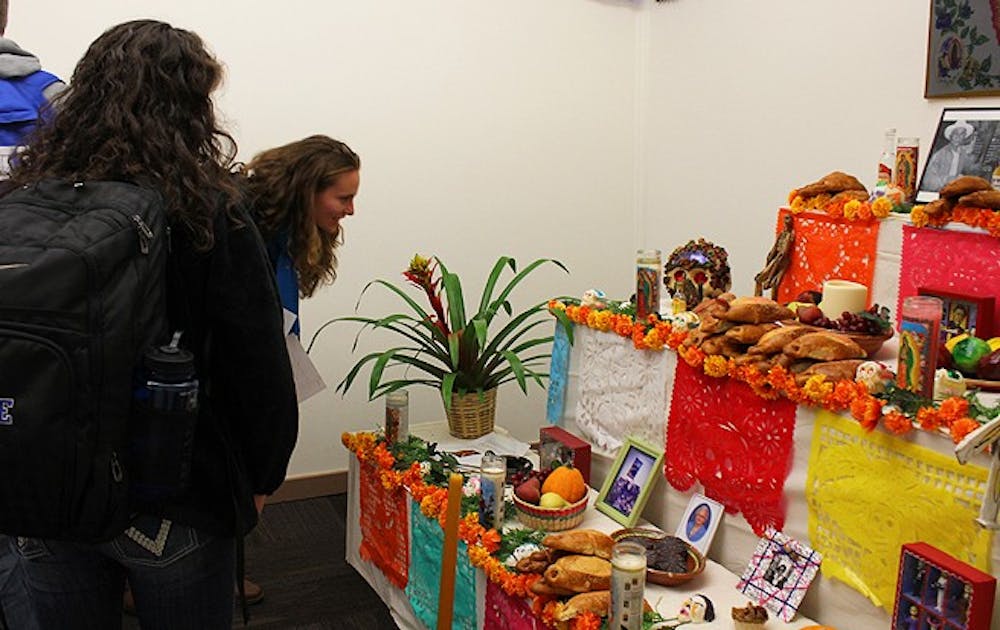Duke’s “Days of the Dead” photography exhibit communicates an un-American way of interacting with the deceased.
As Americans and plenty of Duke students dressed in ghoulish and bewitched costumes to celebrate Halloween, Latinos and Latinas of Mexican descent prepared for their own mid-autumn tradition, said Jenny Snead Williams, co-curator of the “Days of the Dead” exhibit and executive director of the Latino/a Studies in the Global South certificate program. The exhibit features photographs and traditional wares of the Days of the Dead, a Mexican holiday celebrated on Nov. 1-2, during which families honor deceased ancestors through a variety of rituals.
Snead Williams, who was also a photographer for the project, said the exhibit should not only inform its viewers about the community and culture surrounding the Days of the Dead, but also teach about the migration of the holiday into Americana—a culture she said makes discussion of death almost taboo.
“The exhibit is as much about the U.S. experience and transformation as it is about Mexican roots,” she said. “On a larger scale, the examination of how others remember and connect to deceased loved ones prods us to consider our own societal tendencies to push death aside and keep it quiet.”
“Days of the Dead,” housed in the Friedl Building on East Campus until Nov. 6, was forged in a joint effort by faculty and students, Snead Williams added. It includes photography and a few video features that highlight the rituals of the postmortem holiday. The photographs span three contiguous walls and chronicle the full-day tradition from morning preparations to late-night celebration. Many of the pieces feature human subjects—young children, adults, the elderly, priests and families, some dressed in colorful garb with their faces painted to resemble sugar skulls.
Snead Williams and co-curator Bill Bamberger were among a group of photographers who travelled to Oaxaca, Mexico last year during the holiday. Oaxaca is rich with traditional Days of the Dead celebration because the southern Mexican state was among the least affected by Catholic pressures to diminish traditional pagan practices, Snead Williams said. Thus, the group was able to capture the height of the holiday in its photographic series.
“We came to appreciate how deeply rooted the Days of the Dead celebration is in the lives of the communities that hosted us,” Bamberger said. “As curators... we were looking for photographs that were informational, telling the story of the Days of the Dead celebration, but also for images that depicted the spiritual, sensory and familial qualities of the celebration.”
Bamberger, an instructor in the Center for Documentary Studies, recalled the customs he and the photographers experienced in their stay in Oaxaca, emphasizing the visit they made to the famed Xococotlan cemetery on a night of celebration. He said the warmth and liveliness of the host families are evident in the photographs.
“As families gathered at the graveside for all-night vigils to honor deceased loved ones, our photographers were invited to join in the family circles,” Bamberger said. “In these intimate gatherings, stories were shared along with food and drink. The resulting photographs bear witness to the warmth and intimacy of these night-long gatherings and capture the beautiful quality of candlelight that illuminated the elaborate decorations adorning the graves.”
In addition to the photography and video pieces, the “Days of the Dead” exhibit works to explain the integration of the holiday into American culture. Students from Mi Gente, Duke’s Latino student group, constructed an altar that serves as a centerpiece for Days of the Dead celebrations. As an homage to the lives of the deceased, the altar is adorned with candles, “bread of the dead,” framed pictures and prized possessions of ancestors. The altar is a meeting place for family members and their ancestors’ spirits during the Days of the Dead, Snead Williams said.
“We decided to take part in this event because Days of the Dead is a prevalent and important holiday for some Latino cultures, particularly for Mexican and Mexican-American cultures,” Mi Gente co-President Birdie Rodriguez wrote in an email Thursday. “We believe that this exhibit not only vibrantly adds a Latino cultural presence on campus, but also gives members of the Duke community to join the celebration.”
Duke students also engaged the Durham community in designing the “Days of the Dead” exhibit. Students from Durham’s E.K. Powe Elementary School worked with the curators and Duke students to construct colorful tissue paper murals depicting a sugar skull and a customary “tree of life,” Snead Williams said. Some Powe students were accompanied by Duke students and given guided tours of the exhibit and later took tours of East Campus dormitories.
Snead Williams said she was partly inspired to pursue this exhibit because her spouse has been very ill for a long period of time and has been on the verge of death more than once. She said the exhibit can encourage people not only to reconnect with the deceased, but also to widen their perspective on life and death.
“I can tell you from personal experience as the wife and sometimes-caretaker of a critically health-challenged spouse, my outlook on life, what’s important and how much difficulty I can handle has benefitted from having to face death head on,” she said. “ Perhaps we would be better off as individuals and as a society if we all had life-or-death moments from time to time.”
Get The Chronicle straight to your inbox
Signup for our weekly newsletter. Cancel at any time.

